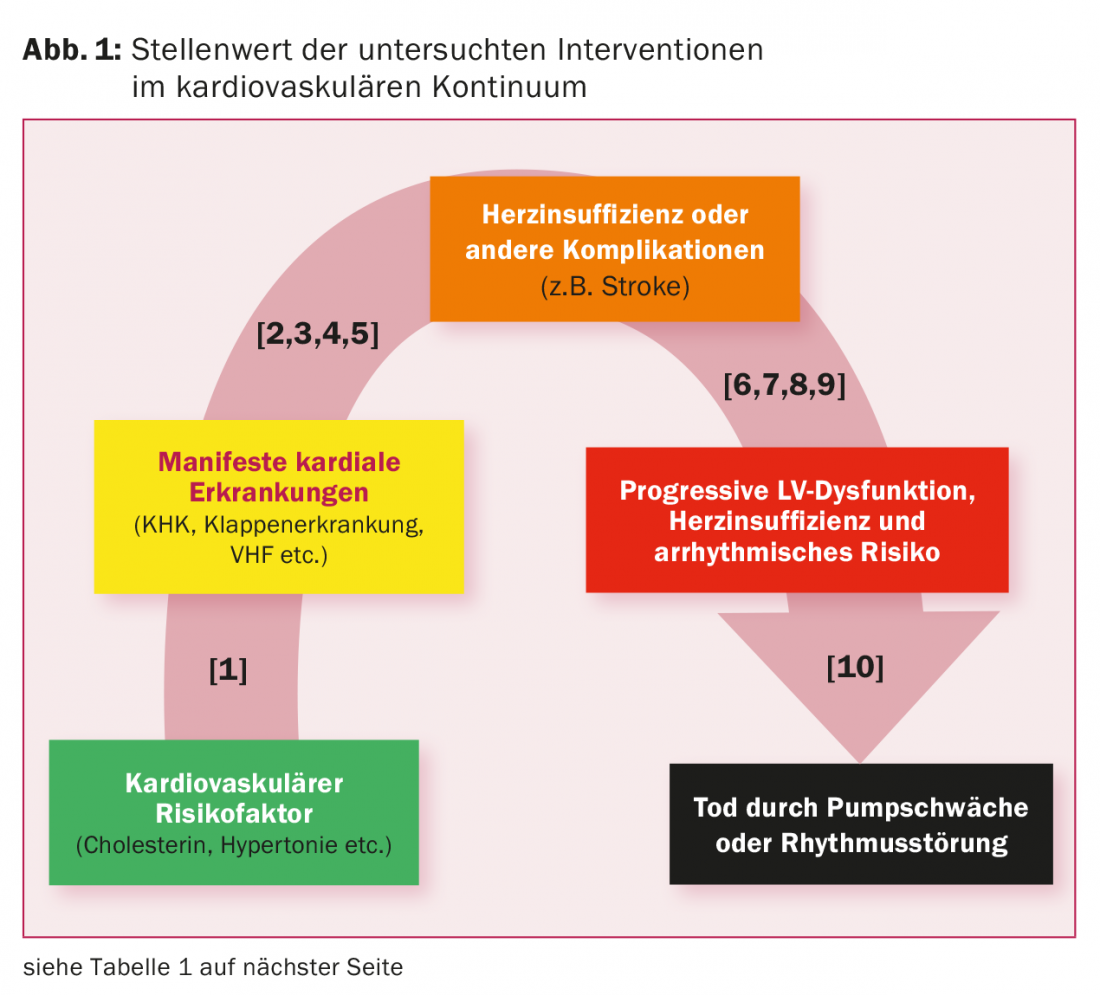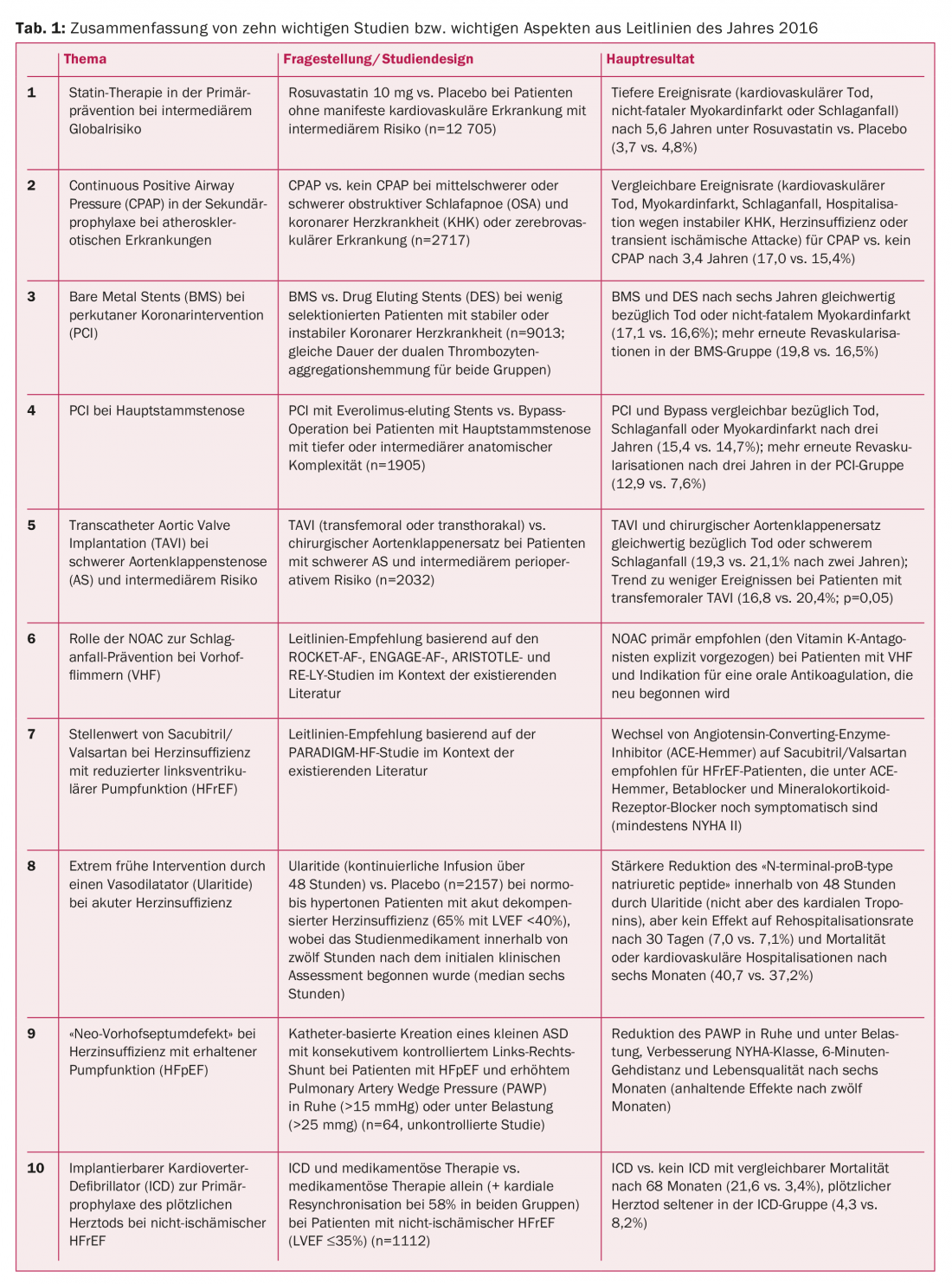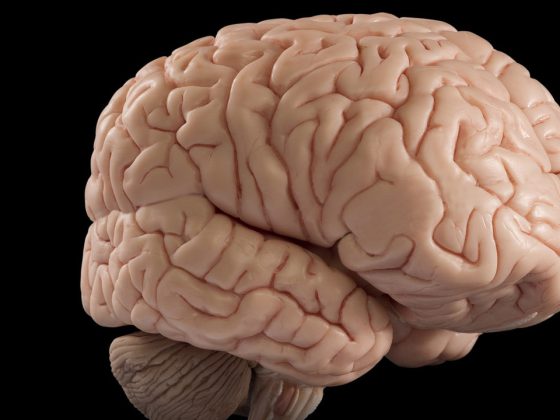This article is a compilation of cardiology highlights of 2016, and although this selection takes into account various aspects of cardiology, it cannot account for all the important publications of the past year.
Table 1 summarizes ten important studies or aspects from guidelines (numbered 1-10 in the table and figure) [1–10]. Figure 1 schematically depicts the place of the interventions studied in the cardiovascular continuum. In the text, there is a short commentary on each of these, although a concluding discussion is not possible.
Statin therapy in primary prevention for intermediate risk.
In the HOPE 3 trial [1], rosuvastatin therapy in patients without manifest cardiovascular disease and with intermediate global risk (LDL cholesterol 3.3 mmol/l) after a follow-up of just over five years resulted in a 24 percent relative risk reduction with respect to the combined endpoint of cardiovascular death, non-fatal myocardial infarction or stroke, this with an average difference in LDL cholesterol of 0.9 mmol/l between the two groups. In the same study design, therapy with candesartan/hydrochlorothiazide 16/12.5 mg resulted in no significant effect compared with placebo (baseline blood pressure 138/82 mmHg, difference in systolic blood pressure of 6 mmHg between groups). Thus, this study shows that statin therapy yields a significant clinical effect even at relatively low global risk in primary prevention, whereas this is not the case for antihypertensive intervention.
CPAP in secondary prevention of atherosclerotic disease.
In recent years, plausible evidence has accumulated for a potentially causal relationship between the presence of obstructive sleep apnea (OSA) and cardiovascular risk factors and disease, particularly arterial hypertension and diabetes or coronary artery disease. Now, for the first time, a large intervention study is available that randomized patients with moderate/severe asymptomatic (no daytime sleepiness) OSA and coronary artery disease or cerebral vascular disease (50% with coronary artery disease) to continuous positive airway pressure (CPAP) therapy in addition to drug therapy or to drug therapy alone and showed no effect of CPAP with respect to the occurrence of cardiovascular events [2]. However, the power of this study is limited by the relatively poor CPAP adherence (3.3 hours per night).
Bare metal stents (BMS) in percutaneous coronary intervention (PCI).
In everyday clinical practice, at least in Switzerland, virtually only coated stents (DES) are used, while BMS are disappearing from cardiac catheterization laboratories. The NORSTENT study has now ventured a recent comparison of DES and BMS in “all-comers” treated with PCI (majority unstable coronary artery disease), thus putting the perceived sky-high superiority of DES somewhat into perspective [3]. There was no difference in terms of hard clinical endpoints at six years. Repeat revascularizations (difference driven by more target lesion revascularizations) were more frequent in the BMS group. The latter result was expected, but the difference was not massive. The study thus recalls that BMS may well still be implanted if a short duration of dual antiplatelet therapy is needed. However, BMS had not shown an advantage over DES in terms of stent thrombosis occurrence, and there are now also data showing that dual antiplatelet therapy for only 1 month is possible with certain DES without loss of superiority over BMS in terms of efficacy and safety. A general revival of BMS is therefore not to be expected, but BMS remain an option.
PCI for main stem stenosis
Revascularization for significant main stem stenosis is classically performed by aortocoronary bypass surgery. In the past year, two studies have been published comparing surgery and PCI in main stem stenoses that are not anatomically very complex. In the EXCEL trial (bypass vs. PCI with everolimus-eluting stents), the event rate at three years was comparable [4]. While the 30-day event rate was higher in the operated patients (perioperative phase), there were more events in the PCI group in the further course – accordingly, the longer-term follow-up will be crucial, which is not yet published. The NOBLE study with a smaller number of patients published in the same year showed a clear superiority of surgery. However, state-of-the-art stents were not used in this study.
TAVI in severe aortic valve stenosis (AS) and intermediate risk.
After establishing transcatheter aortic valve implantation (TAVI) as an option in nonoperable patients with severe AS and patients at high perioperative risk, the PARTNER 2 trial [5] has now expanded the range of indications. The study showed that TAVI was not inferior to surgical aortic valve replacement with respect to the primary endpoint of death or major stroke within two years. Patients who underwent TAVI transfemorally even tended to have a better outcome than patients who underwent surgery (p=0.05). The devices and technology for TAVI have continuously improved over the last years and a good performance of the catheter valves has been documented over the follow-up of several years (which is sufficient for the classic TAVI patient). Thus, transfemoral TAVI is a very good or the primary option today for this patient population with severe AS and high or intermediate risk. On the other hand, because of the ever-improving technical feasibility of TAVI in practice, there is a risk of an uncritical even further extension of the indication, on the one hand, to patients who are so ill that they do not benefit from TAVI, and, on the other hand, to older patients at low risk and younger patients. This is delicate, especially since the problems and complications of catheter valves become known only slowly in the longer term (valve thickening with reduced pocket excursion, endocarditis, etc).
Role of NOAC in stroke prevention in atrial fibrillation (VHF).
Very comprehensive guidelines on VCF [6] were published last year, including defining the place of NOAC. Based on the data from the four large comparative trials of NOAC vs. warfarin, the consistent real-life data now available from registries, and the information on the quality of anticoagulation with vitamin K antagonists, the guidelines now clearly recommend the primary use of NOAC when reestablishing oral anticoagulation for stroke prophylaxis in nonvalvular VCF. In practice, the switch to the easier-to-handle NOAC has been underway for some time. As a caveat, it should be noted that the disadvantages of NOAC are also relevant in practice (dose adjustment or contraindication in renal insufficiency, lack of verifiability of compliance).
Place of Sacubitril/Valsartan in HFrEF.
Also in 2016, the new European Guidelines for the Diagnosis and Treatment of Heart Failure were published [7]. This paper had been eagerly awaited because of the question of how the data on sacubitril/valsartan in the PARADIGM-HF trial would be implemented in the guidelines. Sacubitril/valsartan is an angiotensin receptor neprilysin inhibitor (ARNI), which is the combination of an angiotensin receptor blocker and a neprilysin inhibitor. The latter inhibits the degradation of “B-type natriuretic peptide” and thus increases the availability of this endogenous natriuretic and vasodilating peptide. The PARADIGM-HF trial demonstrated that sacubitril/valsartan is superior to the standard ACE inhibitor enalapril in terms of survival and rehospitalizations in patients with heart failure with reduced left ventricular pump function (HFrEF) previously treated with an ACE inhibitor or an angiotensin receptor blocker (no data for ACE inhibitor/angiotensin receptor blocker-naive patients). According to the new guidelines, basic therapy consisting of ACE inhibitors, beta blockers, and mineralocorticoid receptor blockers should first be established at optimal doses. If patients are then still symptomatic (even if “only” NYHA II), an extension of therapy must be sought for prognostic reasons. There are three primary options for this: the ARNI sacubitril/valsartan, the If-channel inhibitor ivabradine, and cardiac resynchronization therapy. These therapies can and should be combined (if possible) during the course, although the data are better for ARNI than for ivabradine, and cardiac resynchronization therapy is indicated only in the presence of a wide QRS complex (patients with QRS >150 ms benefit most).
Extremely early intervention by a vasodilator (Ularitide) in acute heart failure.
Management of patients with acute heart failure is essentially empiric. Loop diuretics, nitrates and non-invasive ventilation as well as causal therapeutic approaches (revascularization, rhythm management, etc.) are the measures in the foreground. Several drugs have been tested unsuccessfully in this setting. The TRUE-AHF study (design paper published [8], study presented at the AHA Congress but not yet published as full text) investigated the hypothesis that very early treatment with a vasodilator has a favorable effect on longer-term prognosis by attenuating the myocardial damage of decompensation. In TRUE-HF, Ularitide achieved a more rapid reduction in congestion signs and “N-terminal-pro-B-type natriuretic peptide” (but not cardiac troponin as a marker of myocardial damage) at the cost of more hypotension. However, no effects were seen on 30-day rehospitalization for heart failure and all-cause mortality. This study contrasts with the smaller RELAX trial, where an effect of a brief, acute intervention with a vasodilator on 180-day mortality was observed. The larger RELAX 2 study is currently ongoing.
“Neo-atrial septal defect” in heart failure with preserved pump function (HFpEF).
For patients with HFpEF, there is still no therapy available that improves survival. The best data for drug therapy are available for spironolactone (reduction in hospitalization for heart failure in the TOPCAT trial, improvement in exercise capacity in patients who respond with an increase in left ventricular end-diastolic filling pressure during exercise). Decompression of the left atrium by a “neo-atrial septal defect” (catheter-based creation of a shunt at the atrial level by a device) was investigated as a new concept for symptomatic treatment. In the uncontrolled REDUCE LAP-HF trial [9], this intervention resulted in a decrease in wedge pressure at rest and on exertion and an improvement in exercise capacity and quality of life, with consistent data at six months and one year.
ICD for primary prevention of sudden cardiac death in nonischemic HFrEF.
Whereas the indication for primary prophylactic use of the implantable cardioverter defibrillator (ICD) in patients with HFrEF after infarction (ischemic cardiopathy) had been relatively clear for some time on the basis of several studies, there was relatively little evidence for the analogous recommendation (ICD in LVEF <35%) in patients with nonischemic cardiopathy.
The DANISH Trial [10] is the first large study to at least partially close this gap. In this study, all-cause mortality in patients with nonischemic cardiopathy and LVEF <35% in the ICD group was comparable to that in the non-ICD group. The risk of sudden cardiac death was reduced in the ICD group, as expected, but this was offset by an increased risk of nonarrhythmic death. Thus, the question remains open whether there are not young patients without relevant “competing risks” who benefit from an ICD. The population of patients with nonischemic cardiopathy is very heterogeneous, and future studies must use cardiac MRI and other biomarkers to identify the “best” ICD candidates from this “collection pot.”
Literature:
- Yusuf S, et al: Cholesterol Lowering in Intermediate-Risk Persons without Cardiovascular Disease. N Engl J Med 2016; 374(21): 2021-2031.
- McEvoy RD, et al: CPAP for Prevention of Cardiovascular Events in Obstructive Sleep Apnea. N Engl J Med 2016; 375(10): 919-931.
- Bonaa KH, et al: Drug-eluting or bare-metal stents for coronary artery disease. N Engl J Med 2016; 375(13): 1242-1252.
- Stone GW, et al: Everolimus-eluting stents or bypass surgery for left main coronary artery disease. N Engl J Med 2016; 375(23): 2223-2235.
- Leon MB, et al: Transcatheter or Surgical Aortic-Valve Replacement in Intermediate-Risk Patients. N Engl J Med 2016; 374(17): 1609-1620.
- Kirchhof P, et al: 2016 ESC Guidelines for the management of atrial fibrillation developed in collaboration with EACTS. Eur Heart J 2016; 37(38): 2893-2962.
- Ponikowski P, et al: 2016 ESC Guidelines for the diagnosis and treatment of acute and chronic heart failure: The Task Force for the diagnosis and treatment of acute and chronic heart failure of the European Society of Cardiology (ESC). Eur Heart J 2016; 37(27): 2129-2200.
- Packer M, et al: Rationale for and design of the TRUE-AHF trial: the effects of ularitide on the short-term clinical course and long-term mortality of patients with acute heart failure. Eur J Heart Fail 2016 November 13 [Epub ahead of print].
- Hasenfuss G, et al: A transcatheter intracardiac shunt device for heart failure with preserved ejection fraction (REDUCE LAP-HF): a multicentre, open-label, single-arm, phase 1 trial. Lancet 2016; 387(10025): 1298-1304.
- Kober L, et al: Defibrillator implantation in patients with nonischemic systolic heart failure. N Engl J Med 2016; 375(13): 1221-1230.
CARDIOVASC 2017; 16(1): 12-16













